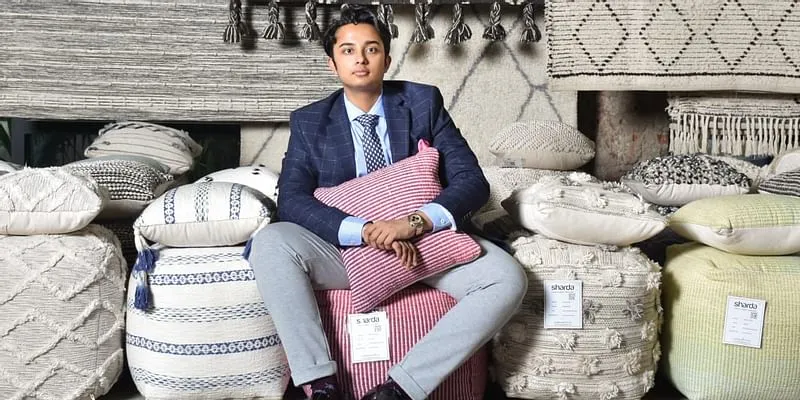From making carpets at home to exporting to 85 countries: the story of The Rug Republic
Aditya Gupta’s parents started Sharda Exports by making carpets at their home in Meerut in 1983. Today, the business exports to 85 countries and has also launched its ecommerce business.
Ever since he had been growing up, Aditya Gupta remained attuned to the carpets and rugs industry. His parents, JK Gupta and Meenakshi Gupta started making carpets at their home in Meerut in 1983 when Aditya was studying in Class X. Eight years later, after completing his education from the Indian Institute of Technology, Roorkee and Faculty of Management Studies (FMS), Delhi, he joined the business along with his brother Ashish Gupta. The company came to be known as Sharda Exports.
The business has grown several times since then but looking back, Aditya tells SMBStory, “My parents did the hard work of getting something off the ground. They took the business from zero to five, which is the most crucial stage.”
The business had been largely selling in the domestic market. The opportunity to expand came when they got a chance to showcase their collection in one of the exhibitions in Germany, entering the global market in 1991. Aditya says the start was small but nevertheless, it contributed significantly in the years to come. One of their first international clients include Swedish furniture giant IKEA and UK-based household furnishings brand Habitat.

The power of branding
Even though the company has been operating for a long time, the year 2013 was a turning point when the company decided to leverage the power of branding. Between 2013-2014, the company was branded and renamed . He says, “Branding becomes the Holy Grail for any manufacturer,” adding that branding not only adds value to the business but also makes the business model a bit more secure.
The company came up with catalogues and started creating content for its customers.
“The handmade rugs industry is not so crowded with brands in India. So we have an opportunity here if we brand ourselves right,” he says.
Today, The Rug Republic manufactures five lakh carpets every year and also exports to 85 countries across the globe. Aditya doesn’t reveal the turnover but adds that the company’s growth rate is around 20 percent year-on-year. The business has an exclusive store in Delhi and has more than 10,000 retail touchpoints worldwide.
Creating quality rugs
The main manufacturing unit of The Rug Republic is located in Meerut. It has also tied up with several units located in the rug belt of Panipat, Haryana, and Uttar Pradesh. The business deploys a mix of sustainable and other raw material options to manufacture rugs.
Aditya elaborates, “The manufacturing process starts right from sourcing the threads, and sometimes even before that. For example, for our PET (rug) range, plastic bottles are first converted into yarn through certain chemical and mechanical processes. Over 300 plastic bottles are recycled to make one rug."
Materials like cotton and wool (used for making rugs) are also sourced locally from farms and converted into thread.
He further adds that recycled materials such as the denim, silk sarees etc, are sourced from around the world which are then sanitised, treated and readied to be made into rugs.
After the initial processes, the threads are dyed into potential different colours. In the meantime, a team of designers come up with myriad designs. The rugs are then prepared using three main methods — hand-tufted, hand-knotted, and hand-woven. In the final stage, they are further finished after undergoing numerous quality checks, design or other refinements.
The rugs can, typically, last for as long as 10 years if used with care and precaution, says Aditya. Three factors that influence the longevity of carpets include — hygiene, humid-free and dust-free environments, and avoiding wear and tear.
The Indian rug Industry
India is well-known for its excellent craftsmanship, and for creating intricate carpet designs. The industry also brings significant foreign exchange to the country. According to a report by research platform IBEF, Indian exports of carpets stood at $1.37 billion in FY20. India is home to several carpet companies including YAK, Saif Carpets, Insigne Carpets, and Obeetee.
Aditya says that the majority of the company’s business comes from the international market, and only two percent comes from the domestic market. He adds that the scale and opportunities in the global rug market is “much bigger than the domestic market.”
He also says that the irony in India is that despite the country being a carpet-manufacturing hub, it still imports a lot of carpets.
He says, “The younger generation is not bothered by whether the carpet is handmade or whether it will last for 20 years.” He says that rug is a fashion item in today’s time and consumers are fine with them lasting for even two years.
“Most of the rugs are being imported from countries where they are made using machines. Machine-made rugs are tough and do well in the Indian environment,” he explains.
Furthermore, COVID-19 which brought the entire world to a standstill and disrupted businesses throughout the globe, brought some predicaments for the company as well — especially on the supply side — but the overall demand has increased.
“People are spending more time at home and that is why the whole pandemic situation has actually boosted the home fashion business worldwide,” he adds.

Raghav Gupta, Director of Ecommerce, The Rug Republic.
Future plans
Going forward, Aditya is betting big on the ecommerce business which is being driven by Raghav Gupta, Aditya’s son who joined the business early this year. “Ecommerce will expand our domestic business and is also a healthy push on profitability,” Aditya predicts. The Rug Republic is listed on Amazon, Pepperfry and a few other marketplaces. It is also selling through its own website.
The father-son duo also plan to expand the business in the European market. They have already set up an office in The Netherlands and got listed on the local online platforms. Raghav is also building an augmented reality platform so that consumers can see how a rug looks in their homes before buying.
Brand building and ecommerce will make the business stable and bolster its growth, Aditya concludes.
Edited by Kanishk Singh









